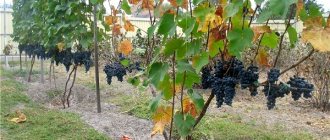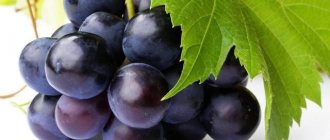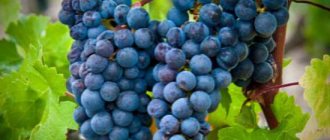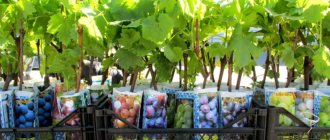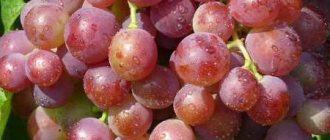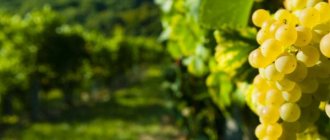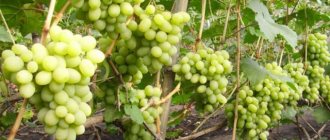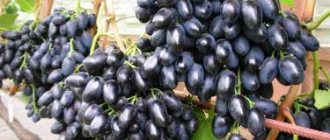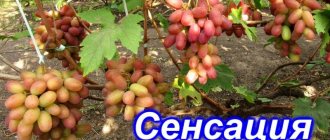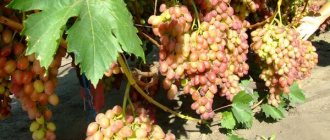Human cultivation of grapes has been practiced since ancient times. The first centers of viticulture appeared in the Middle East 6-8 thousand years ago. From this region, the “sunny berry” spread both to the West - throughout the Mediterranean, and to the East - to Central Asia. At the same time, there was an active process of selection and selection of the best varieties of grapevines, which led to the appearance of magnificent varieties, which after many centuries have reached our days, and today we can see on our tables grapes identical to those grown in ancient times. Few crops can boast of having varieties with a thousand-year history.
One of these wonderful varieties that has long been growing in Central Asia is Taifi, currently presented in two versions - pink and white. It got its name from the Arabian port of Taef, from where, in fact, it was brought during the period of the Arab conquests of the 7th-8th centuries AD. to the original viticultural centers of the region - Samarkand and Bukhara. Subsequently, thanks to its high quality, it gained wide popularity and significantly expanded the geography of its distribution. Currently, Taifi, both white and pink, is still quite popular, and is grown in Uzbekistan, Tajikistan, Turkmenistan, Kyrgyzstan and Kazakhstan. In Soviet times, attempts were made to cultivate the ancient Asian variety outside its traditional range, but due to low frost resistance, the grapes took root only in Transcaucasia and the south of Crimea. Even in the Lower Don region, vines covered with soil for the winter showed severe damage to the buds, which is why fruiting in these conditions was extremely unstable, and for the most part rather meager. At the same time, even if the ripened bunches managed in some seasons to achieve external resemblance to those grown in their homeland, their taste still remained very mediocre, despite the apparent external ripeness.
In addition to very weak cold resistance, Taifi is characterized by other disadvantages, including susceptibility to harmful fungal diseases such as mildew and oidium, as well as susceptibility to spider mites. At the same time, the undoubted advantages of this grape should be considered the excellent taste and presentation of bunches and berries, good suitability for storage and transportation over long distances, the adaptability of plants to such negative features of the Central Asian climate as scorching heat, regular droughts, and soil salinity. In addition, it is also necessary to record the universal use of its remarkable harvest quality as an asset of the variety.
Characteristics of the variety
Taifi grapes are a table variety known to mankind since ancient times. The variety was brought to the territory of Central Asia by the Arabs in the 7th-8th centuries AD. e. through the Arabian port of Taef. Data have been preserved on the cultivation of the variety in vineyards in Bukhara and Samarkand, from where this grape spread. Based on the totality of morphological and biological characteristics, Taifi grapes can be classified as a group of popular oriental hybrids and varieties.
Varieties of culture
The Taifi grape variety is found in two varieties:
Taifi white (Monts)
White, known as Monty. Characterized by a light green tint of berries. A slight pinkishness is observed on the side facing the sun.
- Pink - its fruits are more in demand than those of its white relative. The popular Taifi grape variety is pink because the berries can be used to make delicious table and dessert wines, raisins, jams, compotes, and marinades. Despite the abundance of carbohydrates, the fruits are not considered high-calorie. For every 100 g of berries there are 16.8 g of carbohydrates.
Biological description of the variety
The grape variety “Taifi pink” forms vigorous bushes. The standard ripening period for the crop is late. From the stage of bud break to the full ripeness of the berries of this grape variety, it takes from 160 to 175 days. Young shoots have a crown covered with light cobwebby pubescence, and are also characterized by weak coloring and the presence of a dark crimson border. Annual and fully ripened shoots are reddish-brown in color.
The grape leaves of this form are quite large, weakly stratified, five-lobed and oblong-rounded in shape. The lower surface of the leaf blade has bristly pubescence or is completely smooth. Flowers are formed bisexual. The grape cluster is very large, with an average weight of 1.5 to 2.3 kg, with developed lateral lobes. The standard shape of the bunch is cylindrical or conical . The structure of the clusters is loose and located on a long stalk, which is characterized by lignification at its base.
Growing areas
To get the maximum yield, it is necessary to select optimal growing conditions. For the Taifi variety, these conditions are:
- When ripening, the temperature should be 28-32 °C. The grape bush awakens at a temperature of 10 °C.
- Maximum amount of light. If the bush is in the shade or the daylight hours are not long enough, this will negatively affect the yield and sugar content of the fruit.
- 400-700 ml of precipitation per year. With this amount of moisture, Taifi grapes develop normally and produce high yields.
- Taifi is not picky about soils, but light soils containing sand, crushed stone and pebbles are considered optimal.
Attention! If groundwater flows high, then watering is required even less frequently.
Growing Taifi on an industrial scale requires plenty of heat and sunlight. With a lack of sun and cool weather, the berries become smaller and sour. The bushes on the site are located so that they receive as much sunlight as possible.
Frost resistance indicators are low, so grapes require mandatory shelter for the bushes for the winter if grown in mid-latitudes.
Planting period
Taifi is planted according to the standard scheme:
- Site preparation. Grows well in south-eastern areas, shaded from drafts and strong winds. It is best to place bushes near the southern or southwestern walls of buildings. If cultivation is planned in an open area, trees are planted on the western and northern sides and a light fence is built to protect from the wind. Humus is added to the soil and then dug up. Dig holes at a distance of 3 meters from each other. A vertical support is dug into each hole in advance.
- Preparation of seedlings. The rhizomes are pre-treated with Kornevin or another stimulant.
- The seedling is lowered into the hole, the roots are straightened and the hole is filled with earth. Since the young vine is short, it is immediately tied to a support.
Afterwards, the young bushes are watered abundantly. To reduce moisture loss, it is recommended to immediately mulch the space around the bushes with peat, sawdust or dry leaves.
This link will tell you about the white Muscat grape variety.
The heat-loving plant prefers areas with plenty of light and no drafts.
Ripening period
This is a late-ripening variety, full ripening from the moment the eyes appear is 165 - 170 days. The berries are fully ripe by the beginning of October. When the berries are fully ripe, leave them on the bushes for a long time; this will not affect their taste and keeping quality.
The Taifi variety is most common in Uzbekistan and Central Asia, where it originated. The warm and dry climate of these regions is most suitable for growing the variety. The southern regions of Russia are also suitable for cultivating the Taifi variety, but strict adherence to agricultural techniques is required.
In central Russia, and even more so in the northern regions, getting a good harvest of this variety of grapes is problematic. Cold winters, even with shelter, are detrimental to the plant. Considering that it is quite common in Central Asian regions, it is cheaper to bring it from there than to grow it.
Before you start planting seedlings, it is necessary to carry out a number of preparatory work. They can be divided into three important stages.
- Determination of planting dates. Considering the heat-loving nature of this variety, planting in the fall can be carried out only in the countries of Central Asia. This is the period from October to early November. In other regions with a more temperate climate, it is better to choose spring for planting seedlings. You can start in mid-April, by which time the earth will have time to warm up.
- Choosing a location. Tyfi loves warmth and sun. For planting, you need to choose sunny places, protected from wind and drafts. The southern corner of the house or slope is perfect.
- Soil preparation. Despite the fact that this variety is very undemanding to soil, it is better to grow this plant in nutritious soil. The soil should include compost, sand and mineral fertilizers. Planting in prepared soil increases the survival rate of seedlings and accelerates their growth.
- Selection of seedlings. For planting, it is better to use grafted seedlings; they take root faster and grow. It is better to purchase planting material from trusted sellers or a nursery. Before purchasing, you need to inspect the root system; there should be no damaged or diseased shoots on it. The eyes should also be checked to ensure they are not dry.
Landing
Once a location has been chosen, the soil has been prepared and seedlings have been purchased, you can begin planting a new vineyard. The process of planting in the ground itself consists of a series of sequential actions.
- The pits for planting are prepared in advance, 2-3 weeks before the work. The average size of the recesses is 80x80 cm.
- A drainage layer of fine crushed stone or broken brick must be poured onto the bottom. For Taifi, you can make this layer larger than for other varieties, since it does not tolerate waterlogging.
- A third of the hole is filled with prepared soil and watered.
- A seedling is placed on the surface of the poured moistened soil and its roots are straightened.
- The rest of the soil is poured into the hole, the surface is compacted a little and watered.
When planting using this technology, you can fully count on a successful result.
Technical characteristics of berries
The berries of the Taifi grape variety are very large. The weight of a ripe berry can vary from 7 to 9 g. They have an oblong or oval shape, and are also characterized by the presence of a peculiar beveled top. The standard berry length is from 2.3 to 2.8 cm. Fully ripened berries are characterized by a fairly bright, reddish or dark pink color with a pronounced purple tint.
The berries have small but noticeable dots on the skin, as well as a moderate coating of a thin waxy coating. The skin of the berry itself is dense, thick and has a very characteristic bright red color on the inside. The pulp is optimally meaty, moderately crispy, dense and juicy, and has a pleasant and harmonious taste. The taste characteristics are quite high.
Caring for young and mature vines
By the time of harvest, the vine has time to ripen by 50–70% - only by November will it be fully ready. But if the summer is cold, the degree of ripening of the vines decreases.
The bush does not bear fruit for the first two years. It strengthens and develops the root system to support the entire harvest in subsequent years. At this time, it is important to form the vine correctly. "Taifi" is a vigorous growing variety, so timely pruning is very important. It is carried out in February-March before the buds begin to open. Don't be afraid to remove more than 90% of the previous season's shoots: this will help the plant produce a better harvest.
How to water correctly
The vine experiences shock after being planted in the ground, so it needs immediate watering. Then, during the first growing season, the grapes should be watered weekly if there has been no rain. There should be enough water to wet the soil to a depth of 15–25 cm. More intense watering will create conditions for the development of root rot.
A mature vine does not need weekly watering: do it as the soil dries out with the same depth of wetting. Effective watering methods reduce the need for irrigation. A drip irrigation system will use water more efficiently, moistening only the area where the roots are located. With this watering, water does not fall on the leaves, which reduces the risk of gray rot and other fungal diseases.
Feeding with fertilizers
When planting grapes, the following are used:
- compost - 2 buckets;
- agrofoska - 300 g.
Fertilizers are mixed with soil, which is placed in the planting hole when planting a seedling. Then, over the course of 2–3 years, the vine uses up the resulting nutrients. It would be wise to do the next fertilization in 2-3 years and maintain the same fertilization schedule going forward.
Mulching with organic fertilizers
Mulching is an agrotechnical method in which the root zone of plants is covered with covering material. This helps prevent rapid evaporation of moisture, prevents the growth of weeds, and prevents damage to roots by spring frosts. Organic mulching is done with grass, straw, shredded leaves, sawdust or compost.
Each mulching method has its own advantages. The layer of organic mulch should be at least 4–5 cm. Mulch is not placed directly near the trunk, and the rest of the space is completely covered.
In modern agricultural technology there is also an opinion that grapes are a heat-loving crop, the roots of which are very fond of heat and sun. Mulch prevents solar heat gain, so it is not recommended for use specifically in vineyards. You can use the method that seems most convincing to you, since there is no scientifically proven data on the relationship between harvest and mulching.
Formative pruning
In the first year of growing the bush, cut back everything above 2-3 growth buds. Leave a couple of strong shoots and remove the rest. Stepchildren need to be cut off as they appear. The bush can be formed into 2 sleeves on a trellis. To do this, a few main vines and fruiting shoots are left, and the rest is removed.
Disease Prevention
Taifi vines are practically not damaged by fungal diseases. They are also resistant to infection by oidium. But in some areas of the Krasnodar Territory, cases of mildew have been recorded.
Mildew is a type of powdery mildew that occurs when the weather is wet and there is not enough free space for air circulation around the bushes.
The disease manifests itself in the form of moldy berries and shoots. Affected berries may dry out and become raisin-like or, conversely, soften and turn purple. The fight against fungus is carried out with fungicides - Trichodermin, Fitosporin-M or another drug. In winter, the fungus remains in the soil: it does not freeze and does not die when digging, so preventive treatment is carried out in the spring in the bud phase, and the next one if signs of infection are detected.
"Taifi" is susceptible to attacks by cluster leaf roller and mealybug. The cluster leaf roller is a butterfly with a distinctive marbled pattern on its wings. The length of the insect is 10 mm. Leafworm caterpillars are yellow-green in color. Butterflies appear in May and fly for about 30 days - during which time they lay eggs. Caterpillars gnaw flowers, ovaries and ripe berries, and also entwine them with cobwebs. Spraying is carried out with insecticides designed to destroy this pest.
Advantages and disadvantages of the variety
Taifi grapes have many advantages that make it very popular and in demand for a long time:
- excellent appearance of the bunches and their marketability;
- excellent taste;
- good transportability of collected grape clusters;
- ability to store crops for a long time;
- no negative impact of drought and high soil salinity on the yield and quality of berries.
However, this variety has very low resistance to low temperatures in winter. In addition, the variety is prone to severe damage by mildew, powdery mildew and spider mites. The taste of berries can become very mediocre if there is a sudden change in the cultivation region and insufficient sunlight.
Diseases and pests
Poor resistance to fungal infections complicates the care of Taifi. The vine is susceptible to mildew and oidium. From the latter you can lose the entire harvest. To prevent oidium, agrotechnical techniques are used:
- pinching stepsons;
- garter of young shoots;
- removing weeds.
These measures improve ventilation of the bushes. In addition, the bushes are treated with Topaz, Chorus, and Strobi. These same remedies are effective against mildew. This disease is provoked by damp weather.
In addition to 3 treatments with fungicides: during periods of shoot growth, before flowering, when fruits are forming, the bushes are fed with phosphorus-potassium fertilizers, and the soil is mulched to normalize humidity.
Among the pests you should be wary of are spider mites. For fall prevention, the soil under the bushes is dug up and all plant debris is removed. The following chemicals are used against the parasite:
- Karbofos;
- Fitoverm;
- Actellik.
Features of care
The “Taifi” grape variety has some features that influence the implementation of measures for caring for the vineyard:
- a sun-loving plant needs regular watering, which requires the use of special irrigation systems when cultivating;
- Watering grape bushes before and after flowering, as well as during periods that are too dry, is mandatory;
- the variety is very responsive to the application of fertilizers, of which it is preferable to use phosphorus and potassium fertilizers;
- Mulching the soil with organic matter has a double effect, which allows you not only to feed the plants, but also to protect the root system from drying out;
- pruning can be carried out both in spring and in autumn, but always at the dormant stage of the plant;
- It is recommended to carry out fan formation of bushes into 3 or 4 arms using medium pruning with 5-6 eyes.
Bushes quite often do not tolerate overload well, so it is very important to carry out timely rationing. In addition, before the stage of mass flowering and after flowering, grape bushes should be sprayed with agents against diseases and major pests.
You may also be interested in the article in which we talk about the Libya grape variety.
Outdoor care
Both young seedlings and adult grape plants require regular care. It consists of watering, fertilizing and pruning.
Care for young grapes is especially important in the first two years.
It is also necessary to properly prepare the plant for winter.
Watering and fertilizing
Taifi tolerates short-term drought and does not need frequent watering, but during the flowering period and during the formation of berries it is extremely necessary. Also, in the absence of autumn rains, it is necessary to water abundantly in October.
It is recommended to water young seedlings regularly as the soil dries out until they take root. For irrigation, use settled water at room temperature.
Fertilizing is applied in early spring, summer and autumn. Organic fertilizers should be applied in the fall, and mineral fertilizers in the spring and summer.
For good plant health and a good harvest, annual pruning is necessary. The Taifi variety is rarely grown on vertical supports; more often the shoots are directed horizontally.
Pruning is carried out in the spring. All damaged shoots are removed completely. Young annuals are partially pruned, leaving the most developed ones. On the remaining one-year-old vines, the tops above the bud are trimmed.
Shelter for the winter
This variety is very sensitive to winter temperature drops. Installing a shelter is a necessary agrotechnical technique.
Cold is detrimental to this variety.
Before laying under the shelter, the lashes must be removed from the support and tied. Considering the vigorous growth of the variety and the power of the shoots, it is better to resort to the construction of a frame shelter.
To create a frame, you can use metal or wood. It is worth stretching non-woven material on top, and additionally covering the ends with roofing felt.
Reviews from gardeners
Taifi grapes belong to the category of varieties that have more positive than negative reviews. To be fair, it should be noted that many characterize the variety as sickly sweet, with an unusual pink “tan”, berries that are slightly elongated on a loose cluster. Most people don’t like the cloyingly sweet taste, as well as the large seeds in the berries.
However, most amateur gardeners would gladly agree to cultivate it, but, unfortunately, the variety takes root and bears fruit abundantly only in areas with a very hot, closer to Asian, climate. For example, in Uzbekistan, such grapes have long established themselves as drought-resistant and salt-tolerant, capable of bearing fruit on various types of soil. The frost resistance of this form is quite low, and it is suitable exclusively for warm regions. There have been cases of freezing of the variety even in Crimean vineyards.
What type does it belong to?
Taifi comes in two types:
White and pink Taifi is classified as a table variety . They can also be classified as a wine-making species.
The wine looks like this:
Wine grapes also include Crasen, Montepulciano and Merlot.
Also, Taifi adapts well to transportation conditions, so it is often grown for commercial purposes.
Amirkhan, Zagrava and Libya can also boast of a long shelf life.
How to plant grapes in the fall (video)
Taifi grapes are a high-quality table variety that is also suitable for drying. It can be stored for a long time and also transported over long distances. This is a very beautiful variety, and, importantly, it forms berries without cracking or peas.
When cultivated in areas with suitable climatic conditions, an excellent harvest is formed every year, delighting winegrowers with large, beautiful clusters and high marketability. This variety needs a lot of lighting and heat for the full ripening of the crop and shoots, so even in the southern regions it is recommended to plant it near main walls that face the southwest or south.
Landing
Taifi is propagated by cuttings. They are settling in well. It is worth planting seedlings on the south side of the house. The bushes grow powerful, this must be taken into account when planting, maintaining an interval of 3 meters.
The variety is not picky about soil composition. In addition to garden soil, it is worth adding to the planting hole:
- 1 liter jar of ash;
- humus 1 bucket;
- sand 0.5 buckets.
The size of the pit is small: depth 0.5 m, diameter 0.6 m. Drainage to the bottom and support are needed. The main requirements for the landing site: 100% illumination during the day, protection from the north wind, deep groundwater.
Gurzuf pink
The variety was bred on the basis of the NMF, Ampelos, by the Ukrainian scientific breeder P. I. Golodrigi in 1987. By crossing the varieties Magarach 124 - 66 - 26 and Muscat VIRA. It is cultivated in large quantities in Central Asia, Krasnodar and Crimea to produce rose wine. The wine produced from the Gurzuf Pink variety has a slightly muscat aroma, which allowed it to receive 8 points out of 10 on a tasting scale at the International Competition. It harmoniously combines taste qualities, making it possible to lead the list of wine varieties growing in the warm climate of the coast.
Features of caring for blackberries of the Black Satin variety
“Gurzuf pink” is a universal grape variety that is used in fresh home preparations and in winemaking. Distinctive features of this grape variety:
- The bush has great growth energy and reaches large sizes in one growing season. The young vine is brown in color and ripens well even in unfavorable weather. Bisexual flowers do not need pollinators.
- The berries are round, bright blue in color, weighing up to 3 g on average, have a thick skin and 4 small seeds. Very juicy berry with a nutmeg aroma.
- Sugar content ranges from 26 to 30%, depending on the growing temperature. Acidity is 8 g per liter.
- Loose clusters of cylindrical or cone-shaped. With an average weight of 300-400 g, the maximum weight can reach 700 g. The high-yielding variety can harvest up to seven kilograms of grapes from one bush.
The variety tolerates temperatures down to -26 degrees, so the distribution area of vineyards is very wide. The berries of this variety ripen even in unfavorable, rainy weather, there is no pea clusters, and they have a high marketability even after long-term transportation. The variety is resistant to fungal diseases and unpretentious to cultivation conditions, but loosening the soil and watering will always have a positive effect on the quantity and quality of the harvest.
Properties of white and pink Taifi
Taifi table grapes have gained immense popularity due to their rich taste. The berries have dense, crispy pulp. Quite juicy and quenches thirst well. The pink subspecies Taifi has a slightly tart flavor, but not astringent. When processed, up to 70% juice is obtained.
The crowns of young shoots are weakly colored, there is a crimson border along the edge, and the pubescence is cobwebby.
Cut bunches can be stored in a cool room until spring. If you leave them in a warm place, the berries quickly fall off and then spoil.
How many calories are in the berry and the calorie content of the juice
Berries have a low calorie content - only 65 Kcal per 100 grams of berries, which turns them into a healthy dessert. A glass of juice contains 200 kcal.
The berries have a high carbohydrate content - 16.8 grams per 100 grams.
Benefits and harms
White and pink grapes differ in their properties. At the same time, the beneficial properties are similar:
- berries contain a large amount of useful substances (organic acids, mineral salts, vitamins C, P, A, group B, micro- and macroelements, amino acids);
- has a tonic, restorative and refreshing effect;
- useful for normal liver and kidney function;
- helps restore the body after strong physical or emotional stress;
- promotes recovery of the body after infectious diseases;
- normalizes sleep, helps strengthen the central nervous system.
If consumed in excess, Typhi can cause disruption of the digestive system.
It is important to consider possible harm:
- fresh grapes and products made from them, raisins are contraindicated for diabetes;
- You should not eat fresh grapes if you are obese, have a stomach or duodenal ulcer;
- not recommended for acute tuberculosis, diarrhea, stomach and intestinal cancer.
In the later stages, it is better to limit consumption of grapes for pregnant women. Sweet juice can cause unwanted fermentation in the intestines, and berries that are not harvested in season can contain dangerous chemicals.
Acidity
The acidity of Taifi grape juice is 7 grams per liter. Moreover, all subspecies of Taifi grapes have a sugar content from 17.2% to 23%. It is also worth learning about the Krasnotop grape variety.
The berries are juicy and can provide up to seventy percent of the juice used in making wine, compote or jam.
To correctly determine acidity, berries from several bunches are taken for testing. The juice squeezed out of them is heated, after which its acidity is determined using litmus paper.
